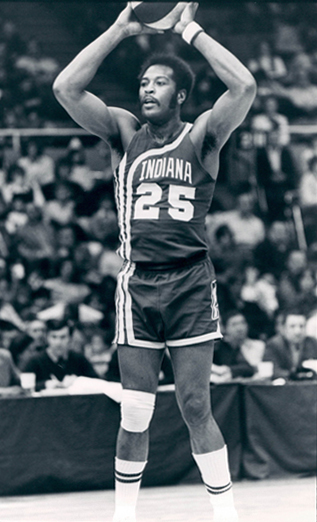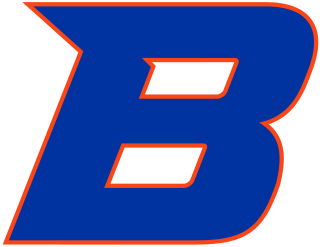Related Research Articles

Gus (Honeycomb) Johnson Jr. was an American college and professional basketball player in the National Basketball Association (NBA) and American Basketball Association (NBA). A chiseled 6 ft 6 in (1.98 m), 235-pound (107 kg) forward who occasionally played center, Johnson spent nine seasons with the Baltimore Bullets before he split his final campaign between the Phoenix Suns and ABA champions Indiana Pacers. He was a five-time NBA All-Star before chronic knee issues and dubious off-court habits took their tolls late in his career.
Donald Lloyd Monson is a former college basketball head coach and the father of head coach Dan Monson. He was a high school head coach for 18 seasons and college head coach for 14 seasons: five at Idaho and nine at Oregon. He was selected by his peers as the national coach of the year in 1982. Monson spent 1993 in Australia, coaching the Adelaide 36ers of the National Basketball League.

Jaycee Don Carroll is an American-born naturalized Azerbaijani former professional basketball player. He has also represented the senior Azerbaijani national team. While playing college basketball for the Utah State University Aggies, he was best known for his scoring prowess, shooting ability, shooting range, and endurance. He has the 2nd highest 3 point field goal percentage in NCAA Division I history. He is the Aggies' all-time scoring leader, and also holds 9 other school records. When he finished his college basketball career, he had the 14th most 3 pointers made, and 52nd most points scored in NCAA DI history.

The Boise State–Idaho football rivalry is an intrastate college football rivalry in Idaho between the Broncos of Boise State University and Vandals of the University of Idaho in Moscow. The game was played annually 1971–2010, and with the exception of the 2001–2004 games, the rivalry was a conference game. Boise State moved from the WAC to the Mountain West Conference in 2011 and the rivalry went on hiatus, with no future games currently scheduled.

The Idaho Vandals men's basketball team represents the University of Idaho, located in Moscow, Idaho, in NCAA Division I basketball competition. They currently compete in the Big Sky Conference. The Vandals are coached by Alex Pribble and play home games at the new Idaho Central Credit Union Arena. This venue, which also houses the women's basketball team, opened in 2021 as the replacement for the Vandals' primary home of the Kibbie Dome, whose basketball configuration was known as Cowan Spectrum, and alternate venue of Memorial Gym.

The Radford Highlanders men's basketball represents Radford University in NCAA Division I intercollegiate men's basketball competition. A member of the Big South Conference, their current head coach is Darris Nichols. The Highlanders play at the Dedmon Center, which has a capacity of 3,000. The Highlanders have appeared three times in the NCAA Tournament, most recently in 2018.

Lawrence Eugene Butler was an American basketball player. He led NCAA Division I in scoring while playing for the Idaho State Bengals during the 1978–79 season. Butler was selected by the Chicago Bulls in the 1979 NBA draft although he never played professionally.
Steven Leonard Hayes is an American former basketball player and coach. He played for several years for a variety of teams in the National Basketball Association (NBA), as well as in the Continental Basketball Association and in Europe. He is also known for his standout college career at Idaho State University, where he is recognized as one of the best players in the school's history.
Chad Copeland is an American former basketball player known for his collegiate career at the University of Tennessee at Chattanooga (Chattanooga) between 1992 and 1994. He was named the Southern Conference co-Player of the Year as a senior after leading the Mocs to back-to-back SoCon regular season and conference tournament championships as well as back-to-back NCAA Tournaments.

Charles Parks is an American retired professional basketball player who spent one season in the American Basketball Association (ABA) as a member of the Denver Rockets (1968–69). He went to high school at St. Ignatius College Preparatory in San Francisco, where he was named the city's prep player of the year. Parks attended San Francisco City College before playing college basketball for the Idaho State Bengals. In his first season with the Bengals in 1966–67, he was an all-conference selection in the Big Sky Conference after finishing third in the conference in scoring, averaging 20 points per game. He moved from playing forward to guard in 1967–68, when he was named second-team all-conference. In two seasons at Idaho State, he averaged 18 points and 5.6 rebounds per game. Parks signed with Denver after they drafted him in the tenth round of the 1968 ABA draft. He was also selected in the seventh round of the 1968 NBA draft by the Phoenix Suns.
The 1979–80 Idaho Vandals men's basketball team represented the University of Idaho during the 1979–80 NCAA Division I men's basketball season. The Vandals were led by second-year head coach Don Monson and played their home games on campus at the Kibbie Dome in Moscow, Idaho.
Bohdan Olexandrovich Blyzniuk is a Ukrainian basketball player for CBet Jonava of the Lithuanian Basketball League (LKL). He played college basketball for the Eastern Washington Eagles, where he was named Big Sky Conference Player of the Year in 2018.

Victor Sanders is an American basketball player for Anwil Włocławek of the Polish Basketball League. He competed in college for Idaho.
The 1960–61 Idaho Vandals men's basketball team represented the University of Idaho during the 1960–61 NCAA University Division basketball season. The independent Vandals were led by first-year head coach Joe Cipriano and played their home games on campus at the Memorial Gymnasium, in Moscow, Idaho.
Ken Owens is an American basketball coach and former player. He is known for his college basketball career at the University of Idaho, and was the Big Sky Conference Player of the Year in 1982.

Quinton Hooker is an American professional basketball player who last played for SIG Strasbourg of the French LNB Pro A. At a height of 1.83 m tall, he plays at the point guard position.

Trevon Allen is an American professional basketball player for Karditsa of the Greek Basket League. He played college basketball for the Idaho Vandals.
Brian Kellerman is an American former basketball player, known for his college career for the Idaho Vandals, where he was the Big Sky Conference player of the year in 1981 as a sophomore. He later played professionally in England and Turkey.
Emily Sann is an American former basketball player. After playing her first year in college at Seattle Pacific University, she transferred to Idaho. At Idaho, she led NCAA Division I women's basketball in scoring in 2004, en route to setting several school records.
Isaac Jones is an American professional basketball player for the Sacramento Kings of the National Basketball Association (NBA), on a two-way contract with the Stockton Kings of the NBA G-League. He played college basketball for the Wenatchee Valley Knights, the Idaho Vandals, and the Washington State Cougars.
References
- 1 2 3 "2010–11 Big Sky Conference Men's Basketball Media Guide" (PDF). Career & Season Bests. Big Sky Conference. 2010. Retrieved September 11, 2011.
- 1 2 3 4 5 6 7 8 Wright, Josh (February 8, 2010). "Then & Now: Orlando Lightfoot". The Spokesman-Review . Retrieved September 11, 2011.
- 1 2 Allen, Jim (March 9, 2018). "Bogdan Bliznyuk becomes Big Sky's all-time leading scorer while leading Eastern Washington to title game". The Spokesman-Review. Retrieved March 10, 2018.
- 1 2 3 4 5 6 7 8 9 10 11 12 13 14 15 Teitel, Jon (August 11, 2011). "Jon Teitel's "Forgotten Legends" Series: Idaho's Orlando Lightfoot". collegehoopsnet.com. Archived from the original on 2011-10-14. Retrieved April 2, 2021.
- 1 2 Gillespie, Matthew (2011). "TSSAA Records Section". Tennessee Secondary School Athletic Association. Archived from the original on September 28, 2011. Retrieved September 11, 2011.
- 1 2 3 4 5 6 7 ESPN College Basketball Encyclopedia: The Complete History of the Men's Game. New York, NY: ESPN, Inc. October 6, 2009. p. 209. ISBN 978-0-345-51392-2.
- 1 2 3 4 5 "Players of the Week". SI Vault: Orlando Lightfoot. Sports Illustrated. Archived from the original on November 4, 2012. Retrieved September 11, 2011.
- 1 2 3 4 5 6 "Orlando Lightfoot". GoVandals.com. University of Idaho. September 16, 2008. Archived from the original on December 3, 2013. Retrieved September 11, 2011.
- 1 2 3 4 5 6 Andersson, Johan; Eriksson, Andreas (2007). "Orlando Lightfoot basketball profile". eurobasket.com. EuroBasket Inc. Retrieved September 11, 2011.